 |
|

|
 |
TABLE of CONTENTS
 |
Commissioner Anderson Kelliher to leave MnDOT |
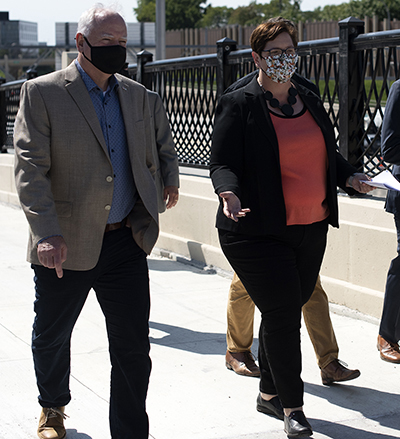
Commissioner Margaret Anderson Kelliher walked with Gov. Tim Walz during a tour Sept. 10 before the press conference announcing the completion of the I35W@94 project. Photo by Rich Kemp |
Commissioner Margaret Anderson Kelliher, who has led MnDOT since January 2019, will be leaving the agency in the next few weeks to become Director of Public Works for the city of Minneapolis, pending approval of her appointment by the Minneapolis City Council.
The announcement came Jan. 7 via news release from the governor’s office.
“Commissioner Anderson Kelliher is an extraordinary public servant, and I am deeply grateful for her leadership at the Department of Transportation,” said Gov. Tim Walz. “Every Minnesotan deserves safe and efficient roads that bring them home to their families, and as we look to the future, our next generations of Minnesotans deserve clean air and a healthy climate. Every day, Commissioner Anderson Kelliher has worked tirelessly toward those goals. I am confident that she will continue to serve Minnesotans well in her new role with the city of Minneapolis, and I thank her for her commitment to our state.”
“I’m grateful for Commissioner Anderson Kelliher’s service to Minnesota,” said Lt. Gov. Peggy Flanagan. “As Commissioner, she led with her values of making sure every Minnesotan has access to a 21st century transportation system that centers safety, efficiency and sustainability. The governor and I thank her for bringing her skills, knowledge and dedication to our administration.”
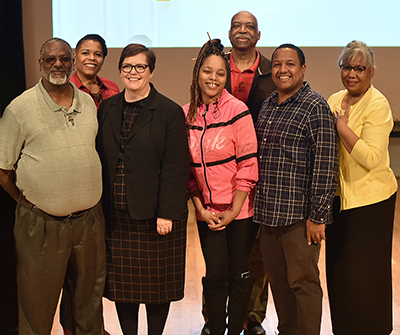
Commissioner Anderson Kelliher joined members of the African American Employee Resource Group during the Black History Month event Feb. 20, 2020. From left are Trumanue Lindsey, Bridge Office; April Lucas, Office of Maintenance; Commissioner Anderson Kelliher; Yashica Taylor, Office of Freight and Commercial Vehicles; Glenn Payton, Office of Human Resources; Jesse Johnson, Office of Freight and Commercial Vehicles; and Victoria Hopwood, MNIT. Photo by Rich Kemp |
“I’m grateful to Gov. Walz, Lt. Gov. Flanagan, my fellow commissioners, and all of the hardworking MnDOT staff for the trust they placed in me as Transportation Commissioner over the last three years,” said Anderson Kelliher. “From securing funding for major safety projects like Hwy 14 and completing the 35W@94 reconstruction, to working closely with partners to improve transit options statewide and centering innovation, climate and sustainability in all of MnDOT’s work, I’m very proud of the progress we’ve made. It’s been my honor to work with the dedicated public servants at MnDOT, and I’m confident that Minnesotans will continue to be served well by this world-class agency.”
In an email sent later to MnDOT employees, Anderson Kelliher noted that her decision to leave was not easy.
“Every day, I am inspired by the commitment MnDOT employees demonstrate in serving our fellow Minnesotans. This agency sets the standard for excellence because of the people who work here, and I am so grateful to have had the chance to be a part of it with you all. Thank you so much for the trust you’ve placed in me to lead this world-class agency.
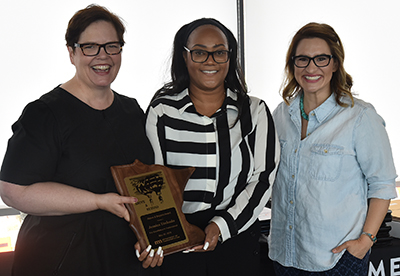
Commissioner Anderson Kelliher and Lt. Gov. Peggy Flanagan presented Jessica Etukudo with an Above and Beyond Award June 20, 2019 during Seeds Phoenix Day. Photo by Rich Kemp |
“The decision to go to Minneapolis comes from a deep love of my adopted hometown, where I have lived with my family for 30 years,” she said. “Last November, Minneapolis voters approved a move to a ‘strong Mayor’ system of government – a major change in our city’s government that requires much work to be done between the Mayor and the City Council. The opportunity to contribute my years of experience in government and transportation to shaping the future of Minneapolis city government is a call of a lifetime.”
Prior to MnDOT, Anderson Kelliher was president of the Minnesota High Tech Association and served 12 years in the Minnesota House of Representatives, including four years as Speaker of the House (2007-11).
As MnDOT Commissioner, Anderson Kelliher oversaw billions of dollars of investment to build safer roads and bridges and improve connections and mobility for people walking and biking statewide. She expanded the agency’s work consulting with Tribal Nations and launched the Sustainable Transportation Advisory Council to help the agency reduce carbon pollution from the transportation sector. She has also served as Chair of the Diversity & Inclusion Committee and Vice President of the Mid-America Association of State Transportation Agencies; Co-Chair of the Governor’s Connected and Automated Vehicles Advisory Council; and Chair of the Minnesota Environmental Quality Board.
The governor will announce the transition process for MnDOT’s leadership closer to the time of the commissioner’s departure.
| |
|

|
 |
TABLE of CONTENTS
 |
Jan. 14 news conference highlights major investment in Minnesota bridges |
“This is truly a transformational investment in fixing and modernizing our nation’s bridge infrastructure.”
~ Commissioner Margaret Anderson Kelliher
|
Commissioner Margaret Anderson Kelliher joined Gov. Tim Walz, Senator Amy Klobuchar and Senator Tina Smith on a virtual news conference Jan. 14 to announce the launching of a major federal investment program for the state’s bridges.
The funding is made possible by the recently passed Infrastructure Investment and Jobs Act that includes a total of $302.2 million over five years to address Minnesota’s bridge improvement needs. Minnesota, which has an estimated 661 bridges in poor condition, will receive $60.4 million in 2022 funding.
“This is truly a transformational investment in fixing and modernizing our nation’s bridge infrastructure,” Anderson Kelliher said. “This historic funding commitment from the federal government – and our partners at the Federal Highway Administration and the US Department of Transportation – will be critical in helping MnDOT ensure our transportation infrastructure remains safe and efficient.”
She said that the agency is working with federal partners on the details of the funding and hasn’t made any decisions yet, but noted that there are some significant and high-priority bridge projects coming up in the next several years that could benefit from this funding, including:
- Interstate 494 over the Minnesota River
- Hwy 61 over the Pigeon River in northeastern Minnesota (a border bridge with Ontario)
- Four bridges on I-94 in Douglas County
- Dunwoody Bridge project in Minneapolis
- Blatnik Bridge in Duluth, a major project in the planning stage now with the Wisconsin Department of Transportation
For more information, see DOT Announces Historic Bridge Investment Under Bipartisan Infrastructure Law (Federal Highway Administration news release, Jan. 14, 2022). |
| |
|

|
 |
TABLE of CONTENTS
 |
Speed, unbelted motorists contribute to Minnesota reaching highest number of traffic deaths since 2007 |
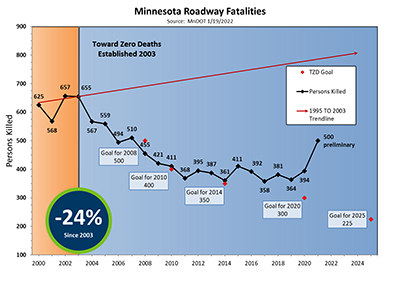
This graph shows large increase in the number of lives lost on Minnesota roads in 2021. |
Minnesota suffered a grim setback in 2021, when 500 people lost their lives in traffic crashes – the most deaths on Minnesota roads since 2007, according to preliminary figures reported by the Minnesota Department of Public Safety. In 2007, 510 people died in traffic crashes; Minnesota averaged 378 traffic fatalities a year from 2016-20.
The slow scroll of names at dps.mn.gov is a somber reminder of friends and family who will never return home to their loved ones.
“Each of those lives lost reaches well beyond the individual lost. Each life lost on our roads also affects the victim’s family and friends, first responders and those who work to prevent deaths on our roads,” said Kristine Hernandez, State Toward Zero Deaths program coordinator. “It’s been a very challenging past two years in combatting deaths on Minnesota roadways."
“One of our strongest assets to combat this trend are the nine Toward Zero Deaths regional coordinators, who mobilize our traffic safety partners statewide. They help support law enforcement mobilizations as well as conduct community education and outreach,” Hernandez added. “Working from home has all but shut those activities down. To adjust, we ramped up planning and added more outreach tools for when we can go back into the communities.”
MnDOT Operations recently provided a one-time substantial investment in safety outreach equipment to show people the effects of different driving behaviors. The new tools include impaired driving goggles, a mini safety town, seat belt convincers, seat belt persuaders and radar feedback signs, plus “buckle up” and “phones down" pavement stencils – and they can be reserved for any event through the District TZD Regional Coordinators.
Speed and unbelted motorists drove increases in fatalities:
- Speed was the largest contributing factor in fatal traffic crashes in 2021.
- In 2021, reported figures show:
- 162 speed-related deaths were a 33 percent increase from 2020 and a 116 percent increase from 2019.
- Speed was a factor in 33 percent of all traffic fatalities in 2021, compared to 26 percent during 2016-20.
- 109 unbelted fatalities in 2021 were 4 percent higher than in 2020 (105 deaths), and 49 percent higher than 2019 (73 deaths).
In addition to deaths in speed-related crashes, preliminary information shows:
- 124 alcohol-related deaths, compared to 135 in 2020 and 114 in 2019.
- 109 unbelted motorist deaths, compared to 105 in 2020 and 73 in 2019.
2021 traffic fatalities include:
- 72 percent were male.
- 67 motorcyclists, compared with 64 in 2020 and 44 in 2019.
- 58 pedestrians, compared with 45 in 2020 and 50 in 2019.
Minnesota reported the first traffic fatality of 2022 on New Year’s Day when a 51- year-old unbelted male driver was killed in Goodhue County. Alcohol and driving too fast for the conditions are suspected in contributing to the crash. |
| |
|

|
 |
TABLE of CONTENTS
 |
Voting begins in 2022 "Name a Snowplow" contest |
|
Voting is now open for MnDOT’s second annual “Name a Snowplow” contest.
All MnDOT employees are eligible to join the public in casting votes for the next round of snowplows to be named in the agency’s snow-fighting fleet. Will it be Edward Blizzardhands? Scoopy Doo & Scraper Too? Betty Whiteout or Sled Zeppelin? You can help decide by choosing from a field of 50 finalists culled from nearly 11,000 names that the public submitted in December 2021.
Vote at mndot.gov/nameasnowplow. Individuals will be able to select up to eight of their favorite names. Voting ends Jan. 26.
The majority of this year’s finalists are new name ideas, but the 2022 finalists also include some runners-up from the 2021 contest.
MnDOT staff and leadership considered a variety of factors when selecting the finalists, including creativity, uniqueness, frequency of submissions, Minnesota-specific ideas, and names that would be easily identifiable and understandable to broad audiences.
MnDOT will announce in early February the eight winning names and areas (one for each district) where the new named snowplows will be located.
|
| |
|

|
 |
TABLE of CONTENTS
 |
Annual agency challenge takes a bite (520 GB, to be exact) out of email storage |
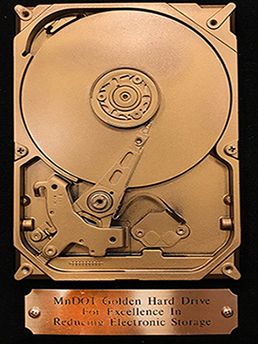
The Golden Hard Drive is awarded to the office or district that reduces the most email storage during December. |
MnDOT employees deleted more than 520 GB of email from Nov. 29 to Dec. 31, 2021, as part of the agency’s annual email reduction challenge. That’s the equivalent of almost 20,000 MnDOT Standard Specifications for Construction, 2020 editions. Thank you for using electronic assets in a more efficient and effective way.
The Office of Chief Counsel won the Golden Hard Drive this year, reducing its email storage more than 10 percent. District 8 had the greatest reduction among MnDOT districts with just over 6 percent. Visit the Email Cleanup SharePoint for all final numbers or the File Storage SharePoint to prepare for the next cleanup.
Previous Email Clean-Up winners:
- Statewide Radio Communications (2020)
- Research and Innovation (2019)
- Transit and Active Transportation (2018)
- Environmental Services (2017)
- Civil Rights (2016)
If you’re looking for tips to use Microsoft products even more effectively (and avoiding, for example, future email build-up), consider attending the new MnDOT Microsoft 365 Trainings and Resources. Upcoming webinars include effective use of Outlook and organization with OneNote. Previous sessions had almost 500 attendees. |
| |
|

|
 |
TABLE of CONTENTS
 |
New library materials available |
The latest issue of New Library Materials is available. This issue features "The Sum of Us: What Racism Costs Everyone and How We Can Prosper Together” by Heather McGhee. New Library Materials is a compilation of resources added to the library collection during the previous month. Visit mndot.gov/library/stay-current.html and click New Library Materials to sign up.
Questions and feedback are welcome at Ask a Librarian.
|
| |
|

|
 |
TABLE of CONTENTS
 |
On the Job: Mao Yang helps shape Local Partnership Program for State Aid Office |
By Rich Kemp

Mao Yang is a project engineer in State Aid Operations. Submitted photo |
Mao Yang has worked her way through the Seeds and Graduate Engineer programs to become a project engineer in the State Aid Office. She started in the Seeds program in 2007.
What is your current job and how long have you been at MnDOT?
I am a project engineer in State Aid Operations. I have been with MnDOT for more than 11 years. I started at MnDOT in the Seeds Program while attending the University of Minnesota for my civil engineering degree. After graduating in 2009, I started as a MnDOT Graduate Engineer in the Land Surveyor Program.
What has been your career path?
I enlisted in the Minnesota National Guard in 2001 while in college. I took a long break from school when my unit, Alpha Company 134th Brigade Support Battalion, deployed to Iraq. After I returned, I worked as security monitor in the Seeds program. While in the Grad Program, I rotated through Metro Traffic, Metro Final Design, Eden Prairie Construction Office, District 6 Materials, and the Ombudsman Office. After the Grad Program in 2011, I worked in State Aid for about five years before taking an opportunity in the Traffic Engineering Office to work on traffic studies. I moved back to State Aid in 2019.
Describe your job.
In this position, I had the opportunity to work with experienced State Aid staff, District State Aid engineers, and consultants in shaping the Local Partnership Program and assist with updating guidance on local programs such as the State Aid Rules and State Park Road Account Program. I enjoyed learning about the progress my predecessors and local public agency partners have made and then continuing to make progress. An example of one of these opportunities is with State Aid’s effort to continually improve how we share and communicate road standards that currently exist on the State Aid system. With a dedicated committee of local public agency representatives, the State Aid staff and a SRF consultant team developed and added a visualization tool to supplement the Chapter 8820 Rules.
What is your favorite part about your job?
This job provides different opportunities to engage, collaborate and learn from experienced professionals working in the different communities around the state about transportation needs and use.
Working at MnDOT has also provided opportunities to connect with others in our communities with diverse perspectives and experiences around transportation. I have enjoyed participating in Lunch and Learn events presented by the Employee Resource Groups, including the Veterans, Fully Utilizing Employees without Labeling, Asian and other groups.
Has your job changed a lot because of COVID-19?
I moved to teleworking from home because of COVID-19. The work has not changed, but it took some adjusting to the available tools that enable us to engage and collaborate with our different partners in the virtual workspace.
Do you or a co-worker have an interesting job to share with readers? Send us your ideas, and we’ll contact you for more information.
Recent employee profiles:
|
| |
|

|
 |
TABLE of CONTENTS
 |
Cultural Resources Unit seeks info on artifacts discovered during construction 60-plus years ago |
By Joseph Palmersheim
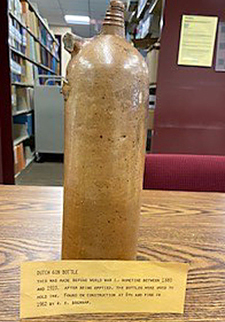
This Dutch gin bottle is one of two bottles found in 1962 at “6th and Pine by R.G. Brennan.” A documentation tag with the item indicates the bottle dates from between 1880 and 1910. This Dutch gin bottle is one of two bottles found in 1962 at “6th and Pine by R.G. Brennan.” A documentation tag with the item indicates the bottle dates from between 1880 and 1910. Photo courtesy of the MnDOT Library |
Somebody found them, cleaned them and saved them.
But what’s the story they are trying to tell?
MnDOT’s Cultural Resources Unit is trying to learn more about some artifacts uncovered during construction in the 1950s and 60s. These items ended up at the MnDOT library after a recently retired employee’s office got cleaned out.
They could be of interest to the Minnesota Historical Society. The society needs more information about each item to provide better historic context.
The items include two bottles, two bones, one miners pick and remnants of abeam from the original St. Paul High Bridge. Here’s what their affiliated tags suggest about each item so far:
- Two bottles (one labeled “Dutch Gin” and one labeled “Old English Ale”) found in 1962 at “6th and Pine by R.G. Brennan”
- A leg bone of a giant prehistoric bison, found during Interstate 35E construction near Maryland Avenue during peat excavation in 1959.
- A prehistoric bison jawbone, found near Interstate 494 and the Minnesota River in 1980 by Gene Fredrick.
- A miners’ pick, found under old “Tote Road” during Interstate 35W construction, north of Hwy 36, in 1962.
- Two pieces of metal beam encased in a block of concrete (weighing 26 pounds), labeled “High–
Bridge 1889 – 1985”
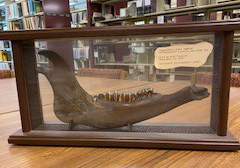
This prehistoric bison jawbone, found near Interstate 494 and the Minnesota River in 1980, could be more than 8,000 years old. Photo courtesy of the MnDOT Library |
“Someone looked at these items at one point and saw the value in cleaning them up,” said Tim Tumberg, MnDOT archeologist. “We’re looking for the context. It’s like the old archeological saying goes – ‘It’s not what we find, but what we find out.’”
Are the items fit for display? Are they historic in their own way? Knowing more could make the difference.
“Stuff is always uncovered during construction, but as far as having items cleaned up, with preliminary analysis done by some as-yet unknown person, that’s a first for me,” Tumberg said. “Any more details would be helpful. It doesn’t have to be much. It’s almost like in crime shows where someone says, ‘If anyone has seen or knows anything…’ Any information would be more than what I have now.”
Do you know anything about these items? Contact Tim Tumberg and let him know.
|
| |
|
| |
|



